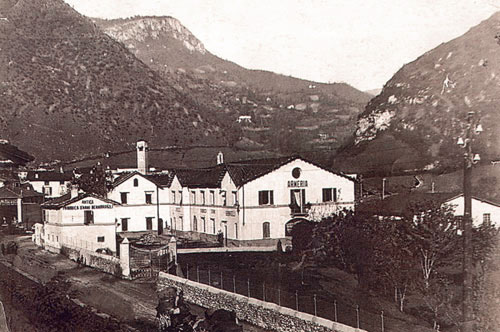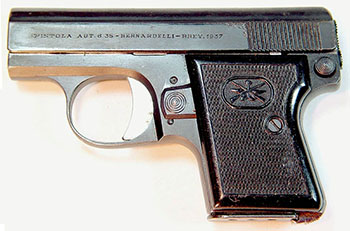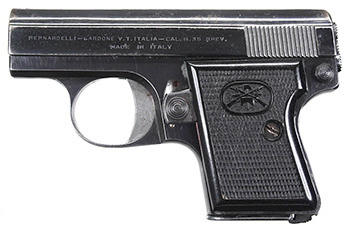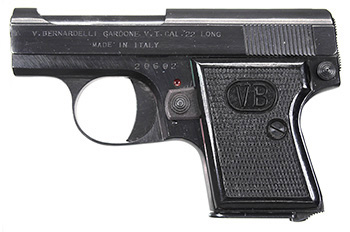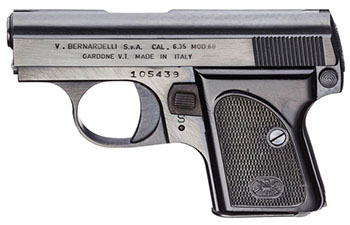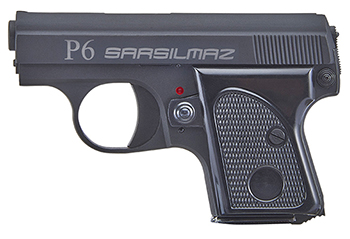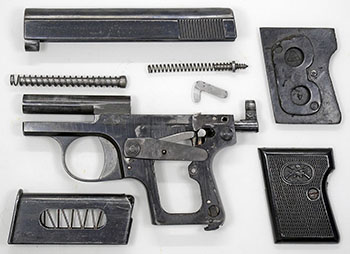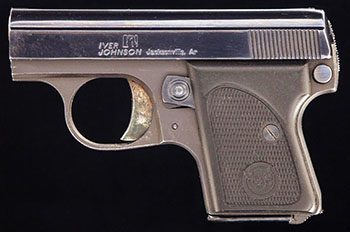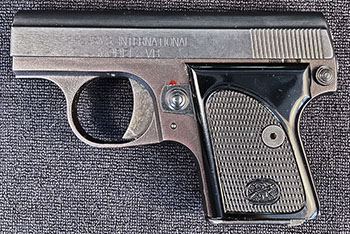 |
||||||||||||||||||||||||||||||||||||||||||||||||||||||||||||||||||||||||||||||||||||||||||||||||||||||||||||||||||||||||||||||||||||||||||||||||||||||||||||||||||||||||||||||||||||||||||||||||||
|
The Bernardelli Vest Pocket Pistol by Ed Buffaloe
Gardone Val Trompia, Brescia, Italy has been a center for iron working and weapons making since the middle ages, and of firearms manufacture since at least 1526 when Giovanni Antonio Beretta began production of arquebus barrels. The Bernardelli forebears entered the firearms business in 1631 when one Bartolino Barnelli married into the noble Acquisti family which owned several gun factories in Gardone Val Trompia. The following year Bartolino’s sister married his wife’s brother to further seal the tie between the two families. No explanation is given as to how the family name morphed from Barnelli to Bernardelli, but in 1721 some brothers Bernardelli are on record as purchasing a large gun factory in Gardone Val Trompia. The company which exists today was founded in 1865 by Vincenzo Bernardelli. According to Matthews: Bernardelli learned the art of firearms manufacture as an employee of the Franzini Arms Factory located in Gardone Val
Trompia. This was one of the important factories of its day, and Bernardelli had become chief of the Damascus barrel
division. In 1865 he had decided to set up his own small factory for the making of barrels in the little village of San Carlo. In
the course of a decade his work had developed to the point where he was making entire guns, although in limited numbers.
In this he was aided by his four sons, Pietro, Lodovico, Antonio, and Giulio, each of whom was responsible for some
particular manufacturing process or detail. The firm soon outgrew its original quarters and began a search for better facilities and room for expansion. New machinery was installed after World War I, but the Bernardelli company continued to utilize water power right up to the end of the 20th century. In the late 1920s the company manufactured components for Alfa Romeo aircraft engines. From 1930 to 1933 the company manufactured the 10.4mm Italian service revolver known as the System Bodeo, Modello 1889, with a total production in excess of 25,000. This was their first handgun. During World War II the company began manufacturing artillery fuses, production of which continued until 1986. After World War II the factory was expanded and the machinery updated again.
In 1997 the V. Bernardelli company was forced into bankruptcy and its assets, brands, and trademarks were acquired by the Turkish company Sarsilmaz. My understanding is that most production was moved to Turkey and that now, once again, only shotguns are being made under the Bernardelli name. Parts for older guns are no longer available from Bernardelli. Sarsilmaz reintroduced the 6.35mm vest pocket pistol for a time as the P6, but it is no longer listed on their website. The Bernardelli Vest Pocket Pistol
Like the Walther Model 9, the Bernardelli VP is a very small unlocked breech striker-fired .25 caliber (6.35mm) pistol with a barbell-shaped takedown latch at the rear. Unlike the Walther, the latch is released by a small button on the left grip tang. The Bernardelli has a full length slide that covers the barrel, with an external extractor on the right side, an internal connector on the left side, and a six-shot magazine—it incorporates a magazine safety. An extended eight-round magazine is available that provides a better grip on this very small pistol. The Walther Model 9 has an open-top slide, a top-mounted internal extractor, an external connector on the right side of the frame, a six-shot magazine, and no magazine safety. The Walther has its ejector built into the frame, whereas the Bernardelli uses the firing pin as the ejector. Both guns have two-inch barrels, and cocking indicators. The Bernardelli has a narrower slide but a deeper grip. The sear mechanisms are similar, but the rest of the lockwork is different. The Walther safety blocks the striker, whereas the the Bernardelli safety blocks the connector. The Bernardelli disconnector is a sickle-shaped lever on the left side of the gun which is depressed by the slide as it moves toward the rear. The disconnector is held in place by the slide and often falls off when the gun is field stripped. The Bernardelli barrel is fixed and press-fit into the frame. My VP is well finished, inside and out, though faint striations from milling may be seen when the finish is examined in strong light. Very early Bernardelli VP pistols are marked in all capital serif characters as follows: PISTOLA AUT. 6.35 – BERNARDELLI – BREV. 1937 “Brev.” stands for “Brevetto”, or “patent”. My Bernardelli vest pocket pistol, proofed in 1949, is marked on the left side of the slide in all capital sans-serif characters as follows: BERNARDELLI—GARDONE V.T. ITALIA—CAL 6.35 BREV. On the right side of the frame are the Italian proof marks. On the pistol shown here we find the mark of the Gardone Val Trompia proof house and the definitive proof for smokeless powder loaded to 30% over pressure. Beneath the proof marks is stamped the year the gun was proofed, in this case 1949. The serial number is stamped on the rear face of the grip tang, as well as on the underside of the slide and the underside of the barrel mount (it can only be seen if the barrel is removed from the frame). There is a photograph of an engraved VP in Hogg and Weeks that is marked only: CAL 6.35 BREV. BERNARDELLI A Bernardelli vest pocket pistol with a proof date of 1957 has the following inscription: V. BERNARDELLI–GARDONE V.T.–CAL 6,35–BREV. The Baby Model
Early Baby Model pistols in .22 short are marked on the left side of the slide in all capital sans-serif characters as follows: V. BERNADELLI–GARDONE V.T.–AUT. 22 SHORT–BREV.. Early Baby Model pistols in .22 long are marked on the left side of the slide in all capital sans-serif characters as follows: V. BERNADELLI–GARDONE V.T–AUT. 22 LONG–BREV.. A .22 short Baby Model, proofed in 1965 is marked on the left side of the slide in all capital sans-serif characters as follows: V. BERNADELLI GARDONE V.T. CAL 22 SHORT BREV. Later, the period was dropped after “BREV” on both long and short models. My .22 long Baby Model, proofed in 1968, is marked on the left side of the slide in all capital sans-serif characters as follows: V. BERNADELLI-GARDONE V.T. CAL .22 LONG My Baby is reasonably well finished, with no rough spots on the inside, but you can see faint mill marks on the frame beneath the blue. The Model 68
V. BERNARDELLI S.P.A. CAL 6.35 MOD. 68 In 2009, Sarsilmaz (the Turkish company that bought Bernardelli) reintroduced the gun as the Sarsilmaz P6. At the Range At the range my .25 caliber Bernardelli VP shot well for a short time, then began failing to feed and eject properly. I finally figured out that the barrel was deformed slightly just past the chamber. It had effectively been “shot out.” However, barrels are still available for these guns and can be easily tapped in and out with a hammer and a brass punch. I replaced the barrel and the recoil spring and the gun functions well now. It will keep all its shots on a paper plate at 20 feet, but will rarely hold a group less than 4 inches across. My Bernardelli Baby in .22 long has always shot well, typically holding about a 3 inch group at 20 feet. It feeds and ejects reliably. I consider these guns curiosities. They are fun to plink with, but can hardly be considered serious self-defense weapons, although if you could throw one hard enough and with sufficient accuracy it would have much the same effect as a rock. Since the safety only locks the connector, I fear the striker could be released if the gun were dropped, so I would not carry one with a round in the chamber. For years I thought the magazine for the VP only holds 5 rounds, but a reader wrote to tell me that his magazine holds six. Then he bought a second magazine, but it would only take 5. He noticed that the angle of the turns of the magazine spring seemed to be opposite to the angle of the follower on the 5-shot magazine. Ultimately, we determined that many of the Bernardelli magazines have the spring in backwards. It’s a bit tricky to disassemble the magazine, but I was able to use two small screwdrivers to pull the spring all the way to the bottom of the magazine. After a few minutes of jiggling, the magazine follower fell out. I was able to remove the spring, turn it around, and with determined effort replaced the follower. Now my magazine holds six rounds.
Field Stripping the Bernardelli
Note: Be sure to notice the location and position of the disconnector as you remove the slide so you can put it back on when it falls off. The flat detent spring for the safety lever is inside the left grip and may sometimes fall out. Iver Johnson Compact .25
The Compact .25 slide is marked on two lines on the left side in sans-serif characters as follows: IVER
The inscription also features a stylized owl’s head logo. The right side of the slide is simply marked “25 CAL.”. The serial number is on the right side of the frame, behind the trigger. The grips are plastic, with the Iver Johnson owl’s head logo in a circle at the bottom of the left grip plate, and the IJA monogram in a circle at the bottom of the right grip plate.
The grips appear to be either original Bernardelli or possibly Bernardelli reproduction grips. The left side of the slide is marked in all capital sans-serif characters as follows: FIREARMS INTERNATIONAL |
||||||||||||||||||||||||||||||||||||||||||||||||||||||||||||||||||||||||||||||||||||||||||||||||||||||||||||||||||||||||||||||||||||||||||||||||||||||||||||||||||||||||||||||||||||||||||||||||||
|
Copyright 2009-2022 by Ed Buffaloe. All rights reserved. |
||||||||||||||||||||||||||||||||||||||||||||||||||||||||||||||||||||||||||||||||||||||||||||||||||||||||||||||||||||||||||||||||||||||||||||||||||||||||||||||||||||||||||||||||||||||||||||||||||
|
||||||||||||||||||||||||||||||||||||||||||||||||||||||||||||||||||||||||||||||||||||||||||||||||||||||||||||||||||||||||||||||||||||||||||||||||||||||||||||||||||||||||||||||||||||||||||||||||||
|
|
||||||||||||||||||||||||||||||||||||||||||||||||||||||||||||||||||||||||||||||||||||||||||||||||||||||||||||||||||||||||||||||||||||||||||||||||||||||||||||||||||||||||||||||||||||||||||||||||||
